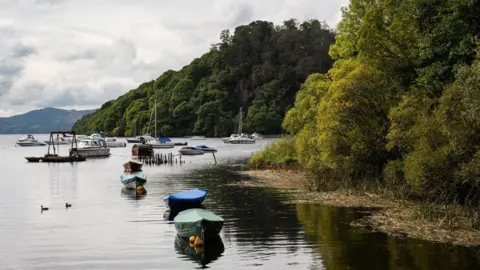Warning after walkers become sick from drinking river water
 Getty Images
Getty ImagesSome walkers tackling the West Highland Way have become unwell after drinking water from rivers, according to National Trust for Scotland (NTS) rangers.
They said at least nine hikers had suffered vomiting and diarrhoea while walking the popular long-distance route over the past month.
The rangers said the people had drunk water from rivers near Balmaha, a village on the shores of Loch Lomond.
Three of them had taken water from The Burn of Mar, and rangers warned that there were farm animals upstream in the area.
In a post on social media, the NTS staff said the hikers' symptoms had only lasted a day or two.
Those affected had filtered the water first, but rangers advised that boiling the water was a safer method.
They warned there were "lots of livestock" upstream of The Burn of Mar.
A NTS spokesperson said: "We encourage anyone drinking from a natural water source outdoors to boil the water first to make it as safe to drink as possible."
The area is within Loch Lomond and the Trossachs National Park.
The park authority recommends that people carry their own treated water to stay safely hydrated.
A spokesperson said: "While Scotland's burns and lochs may look pristine, they can carry invisible risks when used as a water source.
"If you absolutely must drink from a natural water source when outdoors, it's essential to boil the water first to make it as safe to drink as possible."
The West Highland Way starts in Milngavie, near Glasgow, and then winds its way north for 96 miles (154 km) to Fort William in the Highlands.
The route's website has a list of the locations of Scottish Water Top Up taps along the way, as well as details on where other provisions are available.
Tens of thousands of people travel the West Highland Way every year.
The route was established 45 years ago and follows old cattle drover routes and 18th Century military roads.
The journey takes in the eastern shores of Loch Lomond, crosses the sprawling Rannoch Moor, and up the zig-zag ascent of the Devil's Staircase footpath in Glen Coe, before reaching its final destination in Lochaber.
Walking the whole route often takes up to a week, while some people have completed it in shorter times by running or cycling.
 Getty Images
Getty ImagesMountaineering Scotland, an organisation representing the interests of walkers and other outdoor activity enthusiasts, said people should take precautions around drinking from burns and rivers.
A spokesperson said: "In general, being in the Scottish mountains at higher levels above human habitation, the water is safe to drink.
"But there are some key rules to bear in mind.
"It is recommended only to take water from a flowing stream rather than still water, away from paths and people and to avoid sources that are obviously muddy or near or downstream from livestock or where people are camping.
"Boiling water is the most reliable way to ensure it is safe to drink, and there are various filtering equipment on the market, although performance and longevity is determined by a number of factors."
